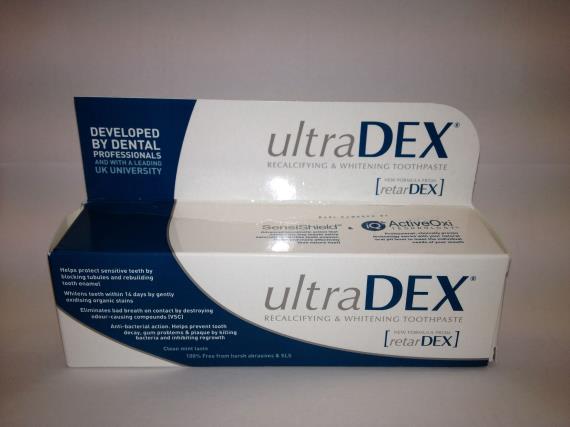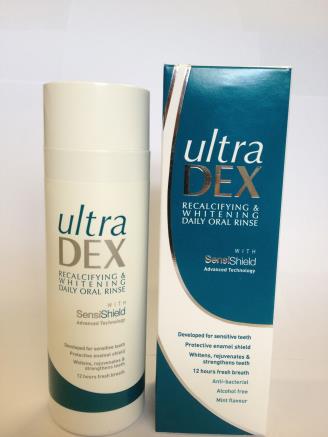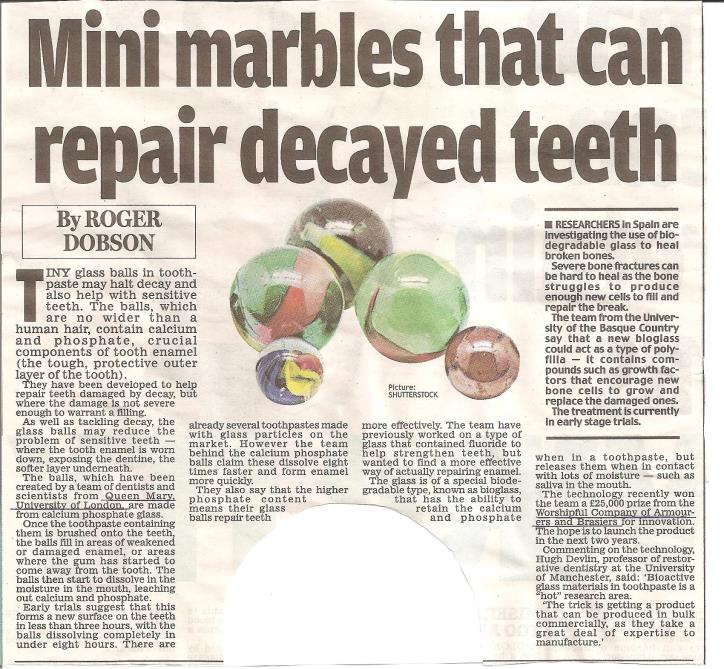Apatite-based additives for oral care products
Submitting Institution
Queen Mary, University of LondonUnit of Assessment
Allied Health Professions, Dentistry, Nursing and PharmacySummary Impact Type
TechnologicalResearch Subject Area(s)
Chemical Sciences: Macromolecular and Materials Chemistry, Organic Chemistry, Physical Chemistry (incl. Structural)
Summary of the impact
Researchers in the Dental Institute, working with Periproducts Ltd, have
developed a toothpaste and mouthwash based on nano-hydroxyapatite that can
treat dentine hypersensitivity and repair dental caries. It is marketed as
UltraDEX® Recalcifying, and sold in Boots and major UK supermarkets. The
researchers have also developed novel bioactive glasses for treating
hypersensitivity. When they come into contact with saliva and water, these
bioglasses release calcium, phosphate and fluoride ions, forming
fluorapatite that binds to and protects the tooth surface. In 2012, Queen
Mary signed an IP licensing agreement with a global healthcare company to
commercialise the new glasses that form apatite faster than the bioglasses
currently on the market. For a sense of the commercial potential of this
development, the market for re-mineralizing hypersensitivity toothpastes
is in excess of £6 billion per year.
Underpinning research
The underpinning research on apatites at Queen Mary's Dental Institute
began with work by Professor Jim Elliott who wrote the classic book,
"Structure and Chemistry of the Apatites and Other Calcium
Orthophosphates", published in 1994. Elliott also invented X-ray
microtomography, a technique that uses X-rays to create cross-sections of
a 3D-object that can later be used to recreate a virtual model. In
dentistry, this instrumentation is used to study small differences in the
degree of mineralisation throughout dentine and enamel, which is of
enormous value in the assessment of carious lesions. Since 2008, Graham
Davis has further developed the technique and instrumentation of
microtomography at Queen Mary. The unique availability of these advanced
instruments provides opportunities for the research group to be involved
in cutting edge dental research and has also opened up some interesting
areas of interdisciplinary research in materials science, archaeology,
palaeontology and petrology. For example, with EPSRC funding, Graham Davis
has used the technology to read fragile historical scrolls that had been
damaged to the point that they could not be physically opened. A
fascinating project in itself, the technological benefits derived from
this study of scrolls will further enhance the group's on-going dental
research.
Following Professor Elliott's retirement, Professor Robert Hill and Dr
Natalia Karpukhina joined Queen Mary in 2009, taking forward the
Institute's apatite and glass research. The research team, now led by
Professor Hill, has a world-leading understanding of bioactive glasses and
apatites. In particular, Hill's team has developed the capability to
perform accurate, reproducible fluoride-19 nuclear magnetic resonance
spectra (19F NMR), an analytical technique used to identify
fluorine-containing compounds that is widely used in dental research. 19F
NMR is the only way that fluorapatite can be distinguished conclusively
from hydroxyapatite. Fluoride plays a key role in preventing caries and
promoting re-mineralization and therefore the ability to detect
fluorapatite formation is of critical importance. The team has used 19F
NMR to show the formation of fluorapatite with fluoride-containing
bioactive glasses and to show remineralisation of enamel following
application of toothpastes. Phosphorous-31 nuclear magnetic resonance has
also been used to distinguish octacalcium phosphate (OCP) from
hydroxyapatite. OCP is thought to be a precursor phase to hydroxyapatite
in tooth and bone mineralization.
Prof Hill and Dr Karpukhina have worked closely with Dr David Gillam, an
expert on dentine hypersensitivity who also has many years' experience in
industry. The team also has the expertise on caries of Dr Paul Anderson
and apatite crystallography skills of Dr Rory Wilson.
References to the research
Key publications:
1. Davis GR Evershod ANZ and Mills D. Quantitative high contrast
X-ray Microtomography for Dental Research. Journal of Dentistry 2013; 41:
475-82.
2. Mohammed, NR Kent NW, R. J. M. Lynch Karpukhina N, Hill R,
and Anderson P. Effects of Fluoride on in vitro Enamel
Demineralization Analyzed by 19F MAS-NMR. Caries Research 2013; 47:
421-428.
3. Brauer DS, Karpukhina N, O'Donnell MD, Law RV, Hill RG.
Fluoride-containing bioactive glasses: Effect of glass design and
structure on degradation, pH and apatite formation in simulated body
fluid. Acta Biomaterialia 2010; 6: 3275-82.
6. Brauer DS, Karpukhina N, O'Donnell MD, Law RV, Hill RG.
Fluoride-containing bioactive glasses: Effect of glass design and
structure on degradation, pH and apatite formation in simulated body
fluid. Acta Biomaterialia 2010; 6: 3275-82
4. O'Donnell M, Watts S, Hill R, Law RV. The effect of phosphate
content on the bioactivity of soda-lime-phosphosilicate glasses. Journal
of Materials Science: Materials in Medicine 2009; 20: 1611-18.
5. Brauer DS, Karpukhina N, Law RV, Hill RG. Structure of
fluoride-containing bioactive glasses. Journal of Materials Chemistry
2009; 19: 5629-36.
7. Mneimne M, Hill RG, Bushby AJ, Brauer DS. High phosphate
content significantly increases apatite formation of fluoride-containing
bioactive glasses. Acta Biomaterialia 2011; 7: 1827-34.
8. Lynch E, Brauer DS, Karpukhina N, Gillam DG, Hill RG.
Multi-component bioactive glasses of varying fluoride content for treating
dentin hypersensitivity. Dental Materials 2012; 28: 168-78.
Key grants
• MRC Grant No. G9824467.EPSRC (2001-2005) >£300k Elliott;
• EPSRC Grant EP/GOO7845/1 (2009-) "High definition X-ray
microtomography and advanced visualisation techniques for information
recovery from unopenable historical documents. " £786k Davis;
• BBSRC CASE Award New Remineralising Glasses for Toothpaste (GSK)
(2010-2014) £130k Hill and Gillam;
• NMR Characterisation of Novamin® (GSK) (2012-2013) £40k Karpukhina and
Hill;
• Numerous contracts with Periproducts Ltd of £9-16k (2010-2013) Hill and
Gillam.
Research prizes
Professor Hill was awarded the Alan Wilson Memorial Prize for Dental
Materials in 2013. Postgraduate students working on bioactive glass and
related areas have won many awards (eg Mneime — 1st prize at 2010 GSK
Research Day; Lynch — best student presentation at the 2011 GABA meeting
in Switzerland; Ahmed — MINTIG Prize at 2012 BSDOR meeting, 2012 ORCA
Young Scientist Prize for her research using 19F NMR to characterise
fluoride uptake in enamel).
Details of the impact
4a. Overview
Apatite and bioactive glass researchers at Queen Mary have invented new
dental materials for the treatment of dental caries and dentine
hypersensitivity. Patents were filed and agreements established with
commercial partners experienced in the oral healthcare market. The first
products based on this research, a toothpaste and mouthwash based on
nano-hydroxyapatite, are already being sold in Boots and major UK
supermarkets under the brand name UltraDEX® Recalcifying. More recently,
Queen Mary established an IP licensing agreement (subject to
confidentiality restrictions) with a separate global healthcare company to
commercialise one of the novel bioglass materials. For a sense of the
commercial potential of these products, it should be noted that the market
for re-mineralizing hypersensitivity toothpastes is in excess of £6
billion per year. Current products on the market include Colgate
Palmolive's Sensitive Pro-Relief and GSK's Sensodyne, which became a
`billion-dollar brand' in 2012.
4b. Industry patents
Members of this research team are named inventors on four patents that
have been filed and published during the REF period (see section 5a). The
first two patents cover fluoride containing bioactive glasses. The third
is a patent filed by Periproducts Ltd on the nano-hydroxyapatite
toothpaste and mouthwash on which there are two Queen Mary inventors, Hill
and Gillam. The fourth covers a bioactive glass composition for making a
cement or an implant that has been invented by Hill, Karpukhina and Kent.
In March 2013, Prof Hill's team filed a GB patent (not yet published) on
bioactive glasses and glass-ceramics containing chloride. This patent and
the commercial plans to exploit it won the Armourers and Braziers Venture
Prize, a national competition with a single £25k prize. The judging panel
comprised three fellows of The Royal Society and leading Business Experts.
4c. Toothpaste on sale
Periproducts initially approached Prof Hill's team to test a prototype
nano-hydroxyapatite toothpaste. This performed poorly with regard to
remineralisation and dentine tubule occlusion. Subsequently Prof Hill and
Dr Gillam worked with Periproducts and, using their knowledge and
previously developed techniques for the characterisation of apatites,
developed UltraDEX® Recalcifying toothpaste and mouthwash. An
international patent (Patent 3 in section 5) has been filed by
Periproducts on which Dr Gillam and Professor Hill are both listed as
inventors. Queen Mary's contribution to the development of these products
is also recognised on the product packaging [see 5b below]. The toothpaste
is sold in the UK in 1,100 of the 1,300 Boots stores, as well as Waitrose,
Sainbury's and Lloyds Pharmacy. It is also on sale worldwide via Amazon.
The mouthwash is on sale in Boots and via Amazon. Both the mouthwash and
toothpaste are based on a nano-hydroxyapatite, but they are marketed as
`biomimetic' products, to overcome any adverse views of nanotechnology in
the target market of over 40 year olds.
4d. Fluoride-containing bioactive glass toothpaste being
commercialised
The team has also developed fluoride-containing bioactive glasses and a
patent has been filed for this technology (see section 5b, patent 2). In
2012, Queen Mary established a licensing option agreement with a global
healthcare company to commercialise this technology. This agreement has
already generated sufficient income (approximately £50k) to cover the
costs of patent filing and the company recently embarked on a scaling-up
process with a view to the commercial production of a fluoride containing
bioactive glass on a greater than 1000kg scale.
The new glasses are being evaluated primarily for use in toothpastes to
treat dentine hypersensitivity, which is estimated to affect 35 per cent
of the world's population (Global Burden of Diseases study). In addition,
the ability of these glasses to stick to the teeth and slowly deliver
fluoride through a more effective delivery system also has potential to
provide much better protection against caries whilst reducing the risk of
dental fluorosis. By contrast, existing fluoride toothpastes use soluble
sources of fluoride that are washed away by salivary flow. Consequently
higher concentrations of fluoride have to be used. Recognized caries
expert Ten Cate from ACTA in The Netherlands has said: "For treatments
to be effective longer than the brushing and salivary clearance fluoride
needs to be deposited and slowly released." (European Journal of
Oral Science 1997; 105 (5 Pt 2): 461-5). In effect, this is what Queen
Mary's researchers have achieved.
The novelty and commercial potential of the new bioactive glass
toothpastes was recognised with the award of the Venture Prize. This major
national prize led to extensive national and international press coverage,
with two articles in the Daily Mail, as well as articles in dental
trade (BDA) and professional journals (BDJ and ADA), and the engineering
(The Engineer) and materials press (Materials World) [section 5c and 5d
below].
Sources to corroborate the impact
5a. Published patents
-
Hill RG and O'Donnell M. "Multicomponent Glasses for Use in
Personal Care Products" WO 2011/000866A2 (Patent 1, January 2011)
-
Hill RG, Gillam DG, Bushby AJ, Brauer D, Karpukhina N and Mneimne
MA. "Bioactive Glass Composition" WO 2011/161422A1 (Patent 2,
December 2011)
-
Hill RG, Collings AJ, Baynes I and Gillam DG.
"Multicomponent Oral Care Composition" Filed by Periproducts Ltd
WO/2013/117913 (Patent 3, August 2013)
-
Hill RG, Karpukhina N and Kent N. `A Composition for Making a
Cement or an Implant' WO2013093101 A1 (Patent 4, June 2013)
-
Hill RG, Karpukhina N Chlorine-containing Silicate Glasses and
Glass Ceramics (not yet published but won Armourers and Braziers Venture
Prize)
5a. Pictures of commercial toothpaste and mouthwash
Note the labeling on the toothpaste `developed by dental
professionals'.


5c. National and international press
The research was widely covered in the professional and lay press (about
30 articles in total). Two examples below — from Daily Mail and Materials
World.


5d. Press release
Press Release From Periproducts on UltraDEX Oral Rinse Detailing
Collaboration with Queen Mary (ImpactUltraDEXpr): http://uk.prweb.com/releases/2013/9/prweb11112569.htm